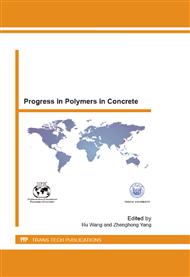p.166
p.175
p.185
p.191
p.198
p.204
p.213
p.219
p.229
Study on the Load-Deformation Behavior of Modified Cement Concrete
Abstract:
The results of experimental investigations of unreinforced and reinforced modified concrete under monotonically increasing load until fracture, simple short-term load at the limit of capacity and repeated load with continuous loading and release rate should be presented. The modification of the concretes was approached in two ways: the variation of the aggregates and the modification of the binder phase with thermoplastic polymers. Of particular interest were the effects of the modifications on the strength properties and the deformation behavior under short-term load. The observed changes in the hardened concrete properties and the non-linear relation between the elastic and inelastic proportions of deformation indicate that such modifications affect the deformation and fracture behavior of concrete significantly. Therefore they have to be accounted for the analysis of capacity and suitability. In addition to the evaluation of the load-dependent deformation behavior, the established approaches to describe the structural state areas are developed further. Therewith, the transitions between the areas can be determined accurately and the dimension of the areas can be quantified. As a result the changes caused by modifications could be compared more precisely.
Info:
Periodical:
Pages:
198-203
Citation:
Online since:
April 2013
Authors:
Price:
Сopyright:
© 2013 Trans Tech Publications Ltd. All Rights Reserved
Share:
Citation:


